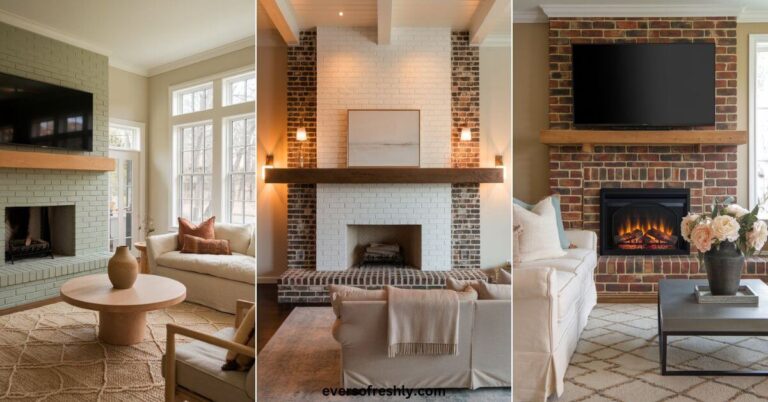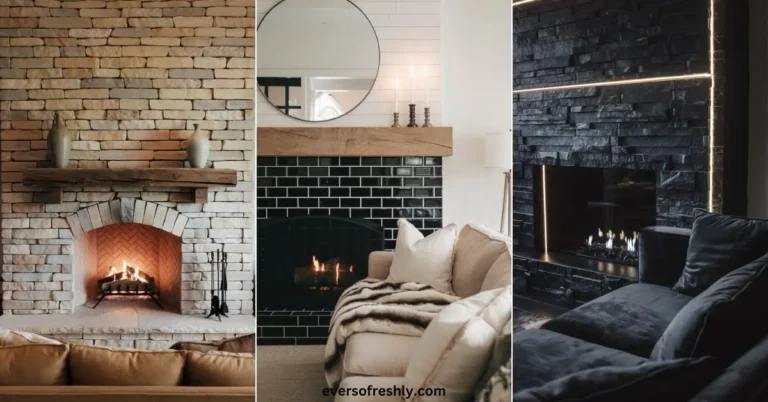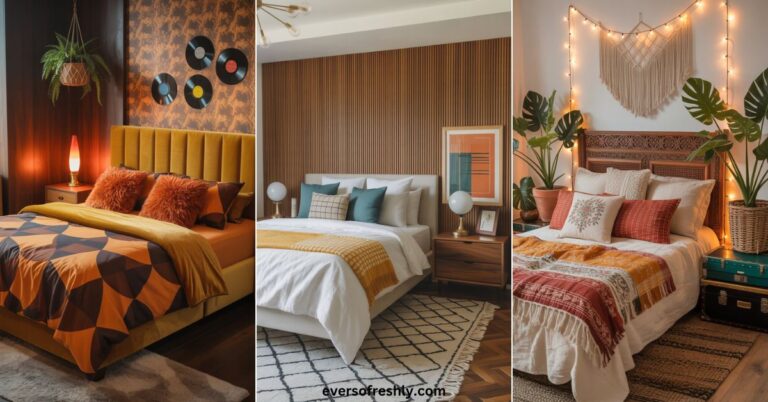23 Japandi Home Office Ideas That Balance Zen and Function
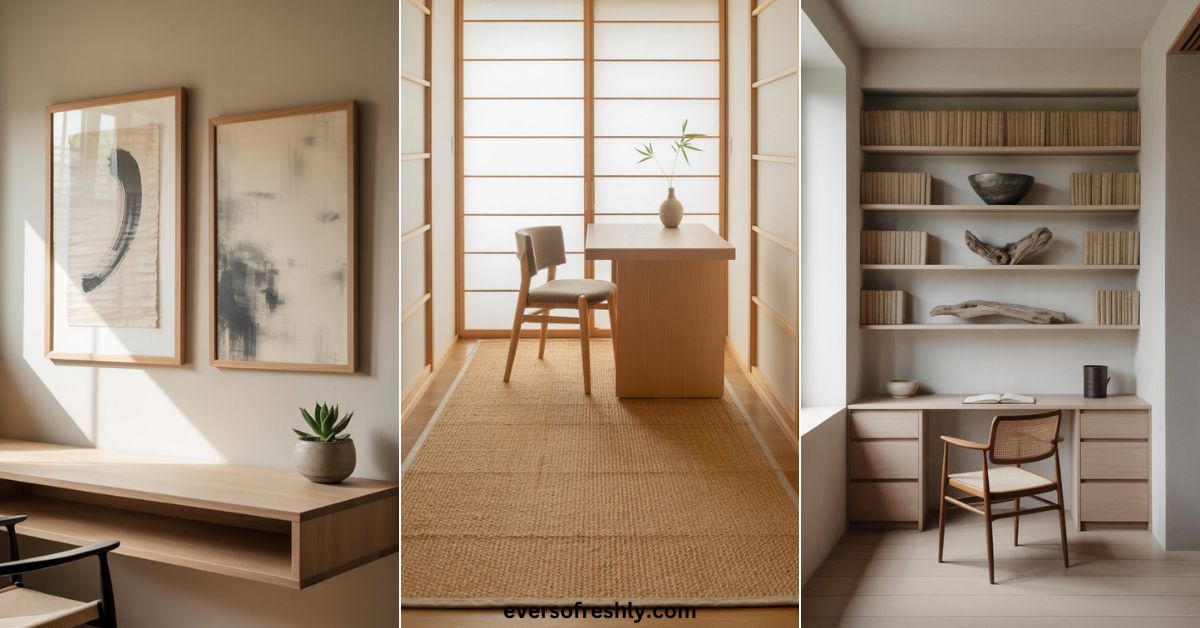
I used to think a home office had to be either stylish or practical—never both. My desk was a mess, my chair didn’t match anything, and don’t even ask about the cords everywhere. It felt more like a storage closet with Wi-Fi than a place to focus.
Then I stumbled across Japandi style—clean lines, calming vibes, and just the right touch of cozy. Suddenly, the idea of a peaceful, clutter-free workspace didn’t feel so impossible.
After a few smart swaps and a bit of creative thinking, my home office became my favorite spot in the house.
Ready to bring calm and style to your workspace, too? Here are some Japandi home office ideas to get you inspired:
1. Choose a Minimalist Desk With Clean Lines
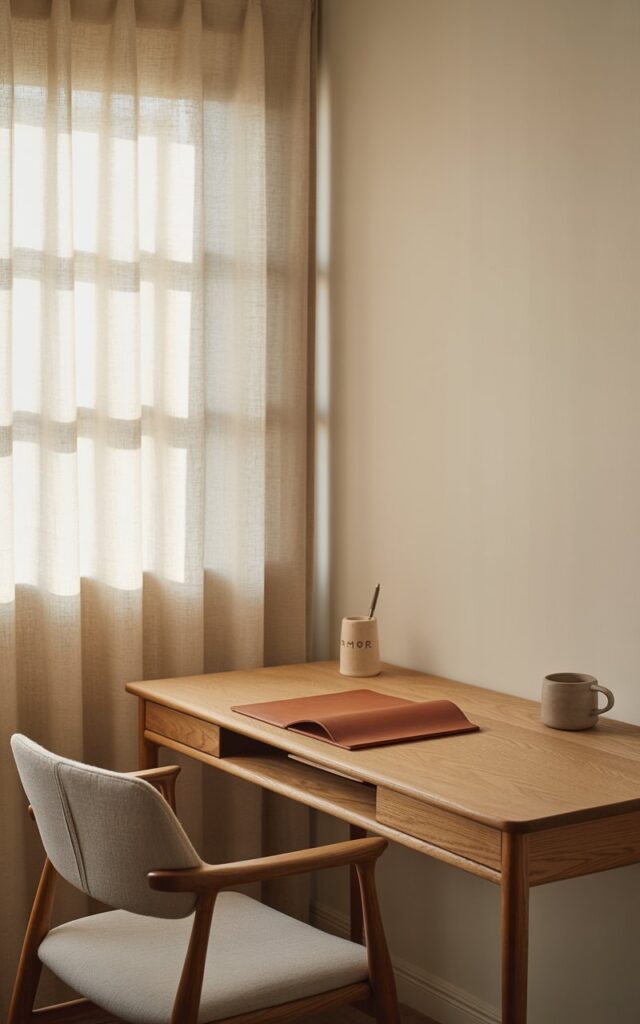
Let your desk set the tone. Japandi desks are simple, functional, and made of natural wood—no frills, no bulk.
Think smooth edges, clean silhouettes, and zero clutter. It’s your creative zone, not a dumping ground.
Choose something that invites focus, feels grounded, and sparks calm the moment you sit down.
2. Use Neutral and Earthy Tones

Color sets the mood. Stick to a palette of sand, soft beige, warm gray, charcoal, and creamy whites.
These aren’t boring—they’re calming. Think of it like a visual exhale.
Earthy tones allow textures to shine and create a space where your mind feels clear and unbothered. Exactly what work demands.
3. Add a Statement Pendant Light

Overhead lighting matters more than people realize.
A sculptural pendant in rattan, ceramic, or linen adds subtle drama without overpowering the room.
It’s functional, sure, but also quietly beautiful. Let it be your room’s soft spotlight—one that helps you stay lit and inspired all day long.
4. Keep Open Shelving Organized
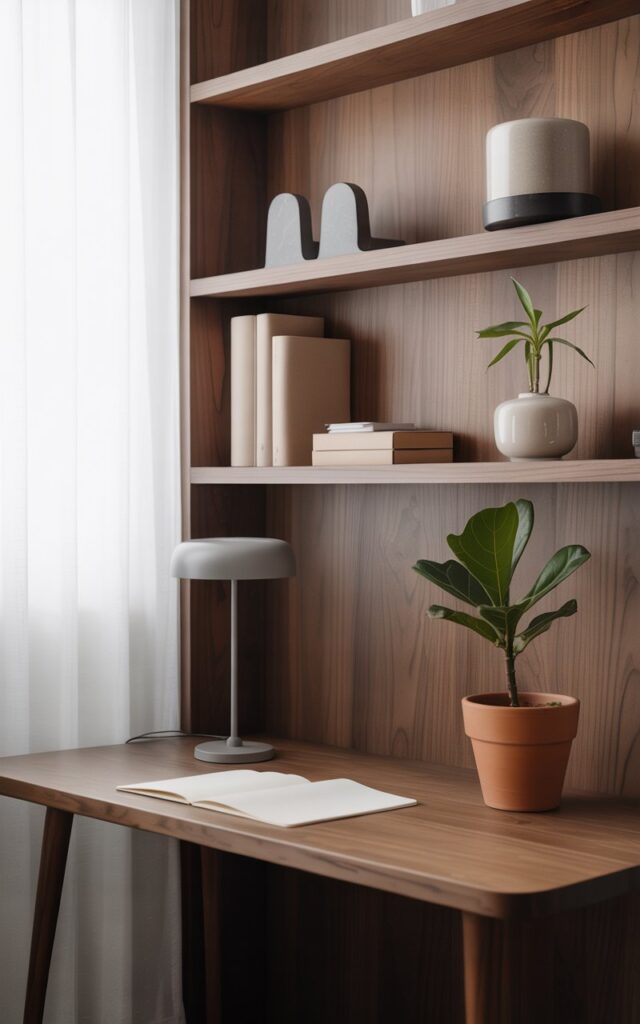
Floating wood shelves are both stylish and practical—but only if they stay tidy.
Use them to display items that blend beauty and purpose: ceramic pen holders, linen-covered journals, even a calming incense tray.
If something doesn’t serve you or soothe you, it doesn’t earn a spot. That’s the Japandi way.
5. Blend Scandinavian Simplicity With Japanese Craft
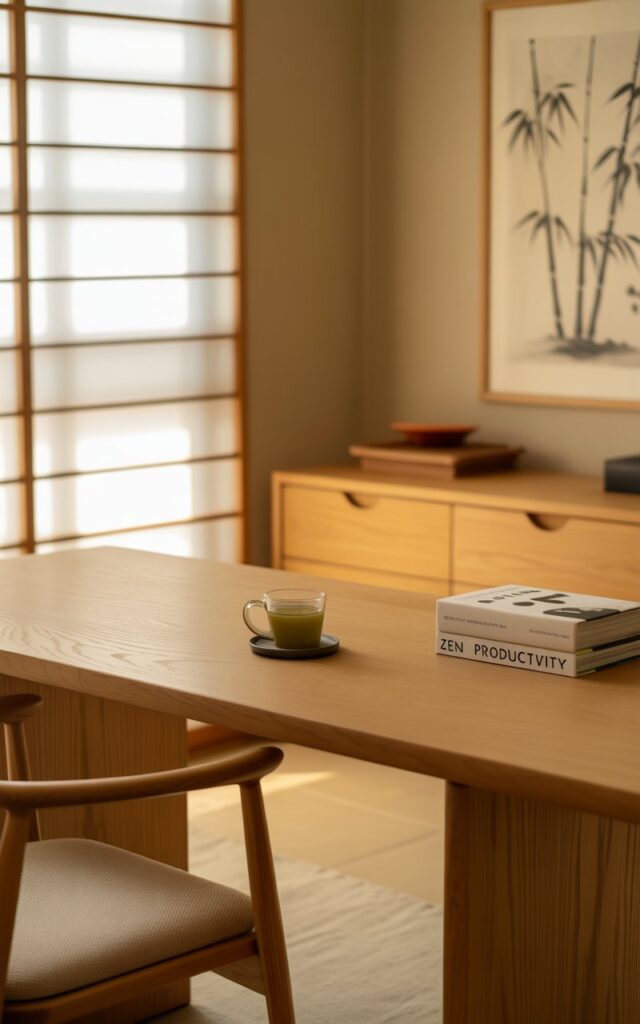
This is where the magic of Japandi really shines.
Mix smooth Scandinavian furniture with Japanese artisanal details—like pairing a birch desk with a shoji-style screen or placing a hand-thrown ceramic mug on a sleek, modern shelf.
The contrast creates a perfectly imperfect harmony that feels intentional, not over-designed.
6. Bring In Nature With a Touch of Greenery

You don’t need a jungle—just one or two thoughtfully placed plants.
A bonsai, ZZ plant, or small fiddle leaf fig brings life and freshness to your space.
Choose neutral pots in ceramic or stone. Plants are not just décor; they’re daily reminders to slow down and breathe between tasks.
7. Use Tatami-Inspired Mats or Rugs
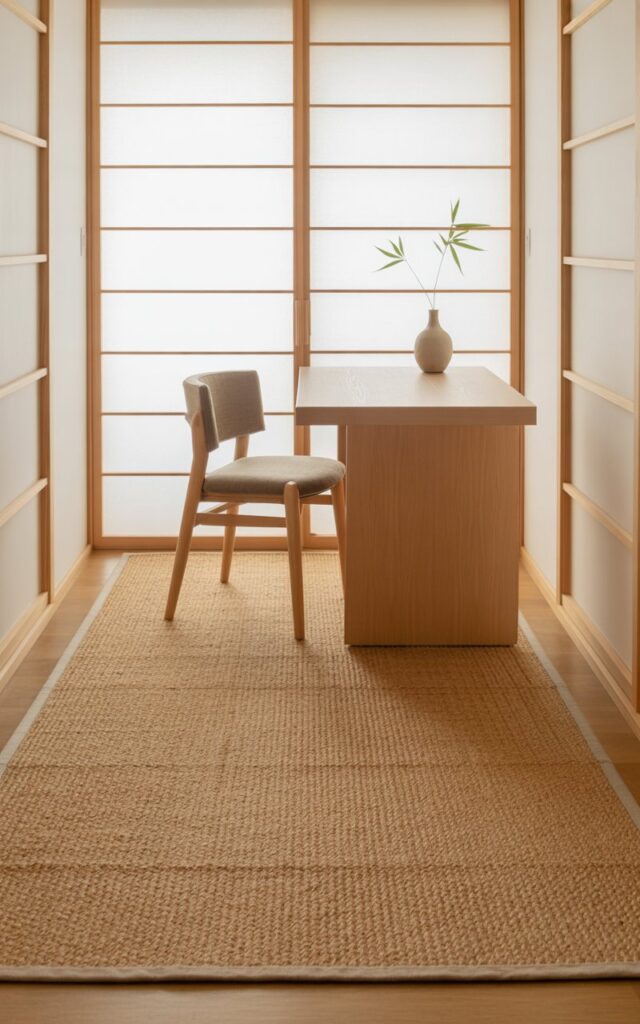
Want to ground the space—literally?
Lay down a jute or sisal rug, or go with a woven tatami mat for something more traditional.
These textures are subtle but rich, giving your feet something natural to land on while keeping the whole room feeling calm, intentional, and a little Zen.
8. Choose a Chair That Marries Comfort and Simplicity

Forget the bulky, black office chairs.
Look for something sleek and supportive—a wood-framed chair with a linen or leather seat, perhaps.
Japandi values comfort, yes, but not at the cost of beauty.
Your chair should invite you to sit tall, stay focused, and look great while doing it.
9. Use Natural Materials Wherever Possible
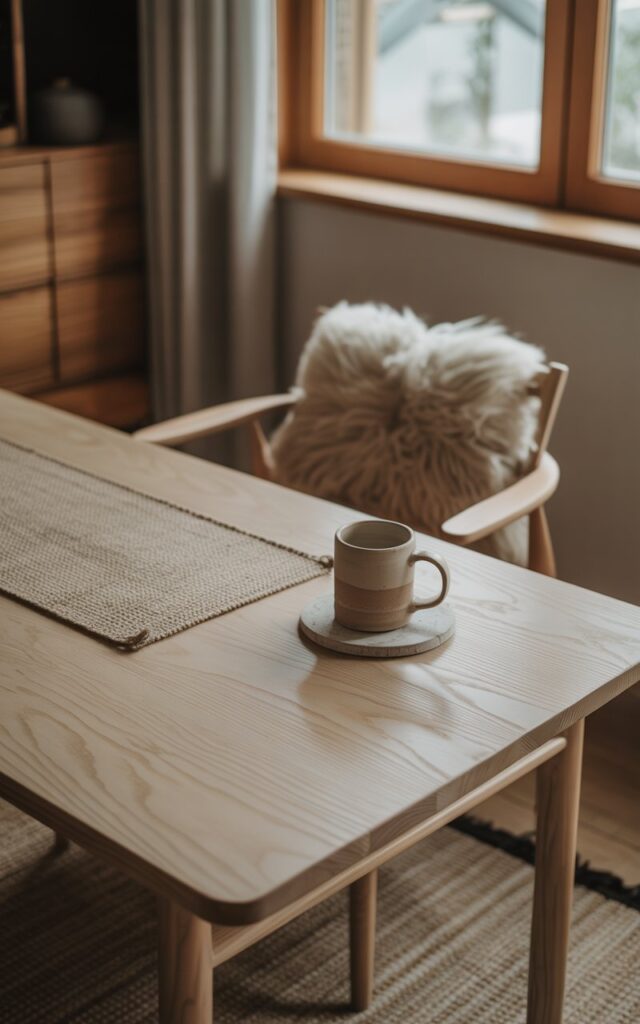
This style is all about authenticity.
Bring in raw wood, clay ceramics, linen curtains, and wool cushions. Nothing plastic, shiny, or synthetic.
These textures add warmth and richness without cluttering the space.
It’s less about “design” and more about feeling connected—to nature, to the room, to yourself.
10. Let In as Much Natural Light as Possible
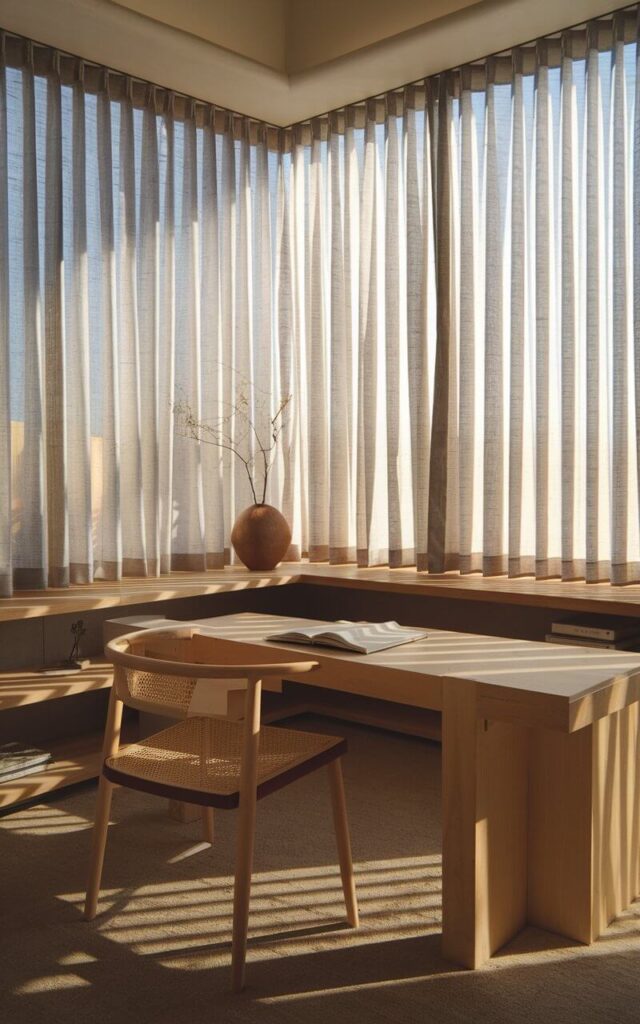
Light is everything in Japandi spaces.
Ditch heavy curtains and let the sunlight pour in. Use sheer linen drapes or leave your windows bare if privacy isn’t an issue.
Natural light brings shadows, glow, and life into the room—and there’s no better mood booster for working long hours.
11. Use Hidden or Modular Storage
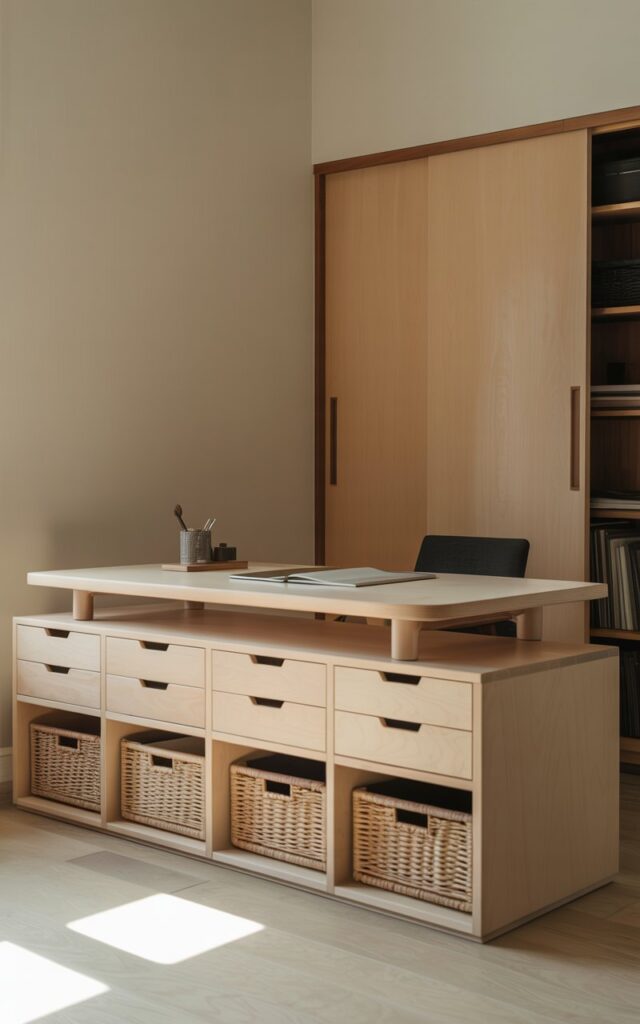
Visual clutter is the enemy of calm.
Store away cables, tools, and paperwork using sleek, modular drawers or natural baskets that slide under your desk.
Everything should have a home—and that home should be hidden.
When your space is clear, your mind follows. It’s science (and great design).
12. Incorporate Wabi-Sabi Decor

Celebrate imperfection with something wabi-sabi: a cracked ceramic vase, a weathered wooden box, or a wrinkled linen runner.
These pieces whisper stories.
They remind you that done is better than perfect and that beauty often lives in the unpolished, the quiet, and the humble.
Let your office breathe like that, too.
13. Keep Wall Decor Minimal Yet Intentional
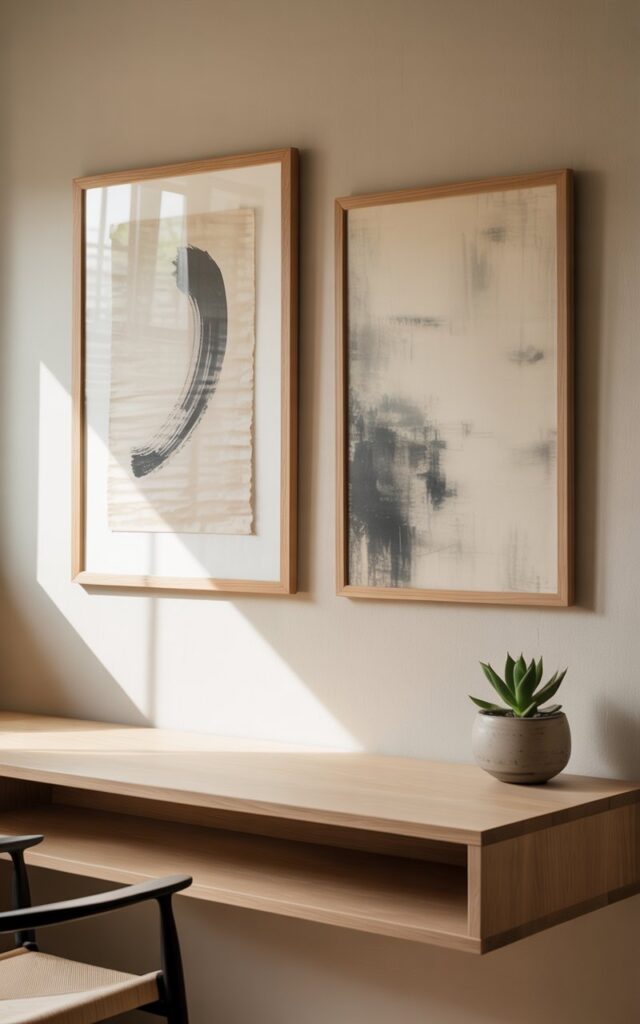
Less is more when it comes to walls.
Choose one or two pieces that truly speak to you—maybe a soft ink painting or a clean abstract print in muted tones. Frame them simply or not at all.
When wall art isn’t screaming for attention, your thoughts can actually focus.
14. Define Zones With a Soft Area Rug
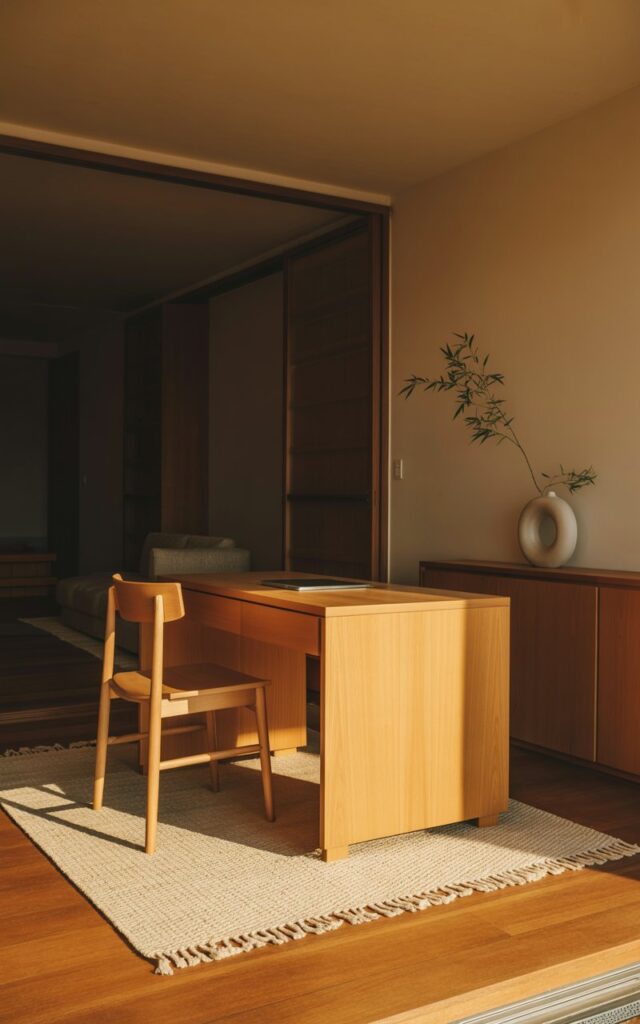
If your office shares space with another area—like a living room or bedroom—use a soft rug to define the boundary.
Go for something low-pile and textural.
A simple rug visually separates your “work” mind from your “rest” self, which makes logging off a whole lot easier at 5 PM.
15. Choose Slimline, Built-In Bookcases

Nothing clutters up a workspace faster than clunky bookshelves.
Opt for slim, built-in shelves painted to match the wall for a seamless look.
Leave plenty of breathing room between books and objects.
When your shelves are calm, the whole room feels more open—and your brain thanks you for it.
16. Add a Touch of Black
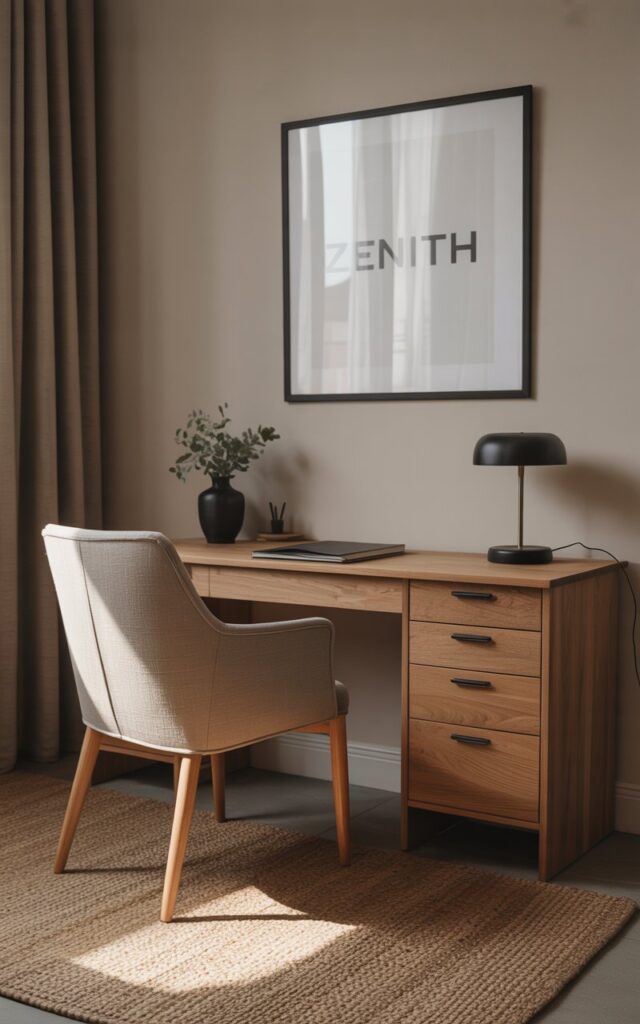
A little black goes a long way.
Whether it’s a matte black lamp, a minimalist clock, or metal shelf brackets, dark accents bring contrast and structure.
They help ground the space without overwhelming it. It’s like eyeliner for your room—subtle, sharp, and just enough to make everything pop.
17. Embrace Negative Space
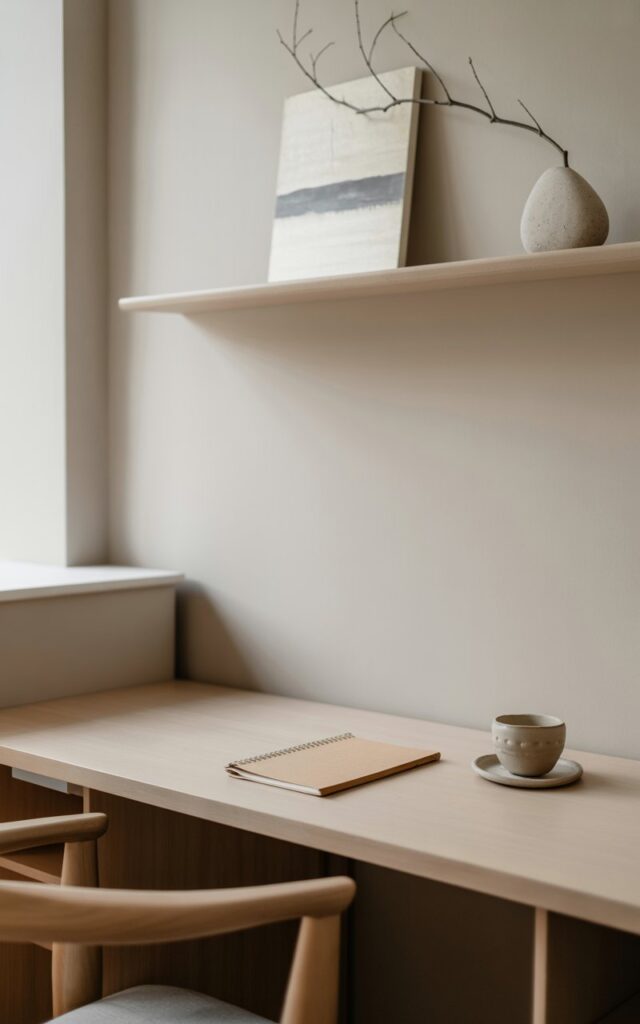
It’s tempting to fill every corner—but don’t.
Negative space is a big part of Japandi design. That empty wall? That bare desktop corner? Leave it.
Negative space gives your eyes a rest, your mind some clarity, and your room a chance to breathe. Sometimes, what you leave out matters most.
18. Keep Cords and Tech Out of Sight
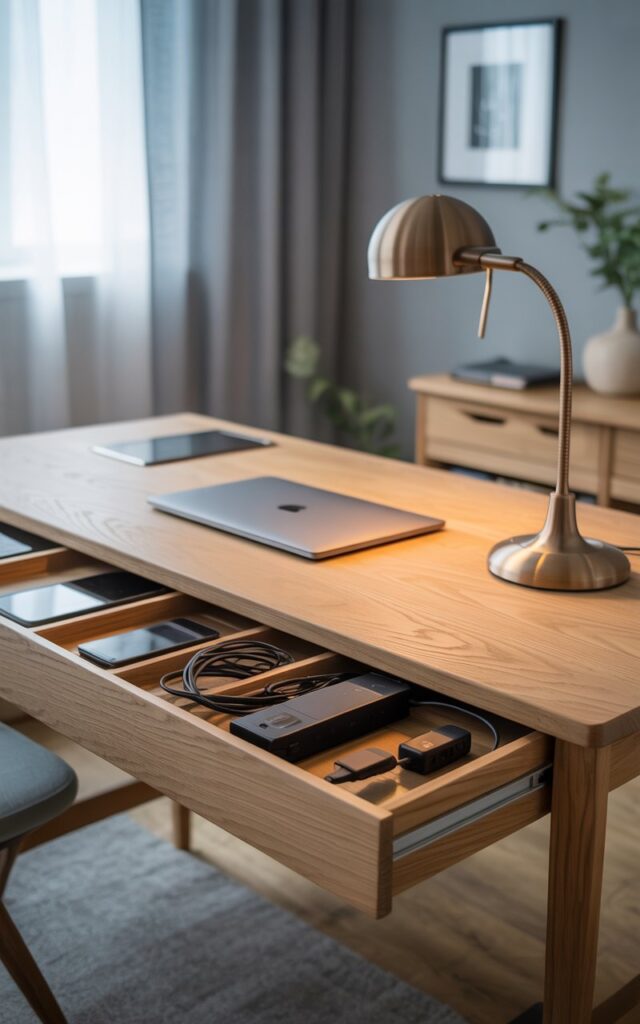
Wires snaking across your desk? That’s a big no.
Use cord organizers, under-desk trays, or even woven baskets to keep tech mess tucked away.
Hide routers and hard drives in drawers or cabinets.
Out of sight means out of mind—which is the goal when you’re trying to focus.
19. Include Soft Textiles for Comfort
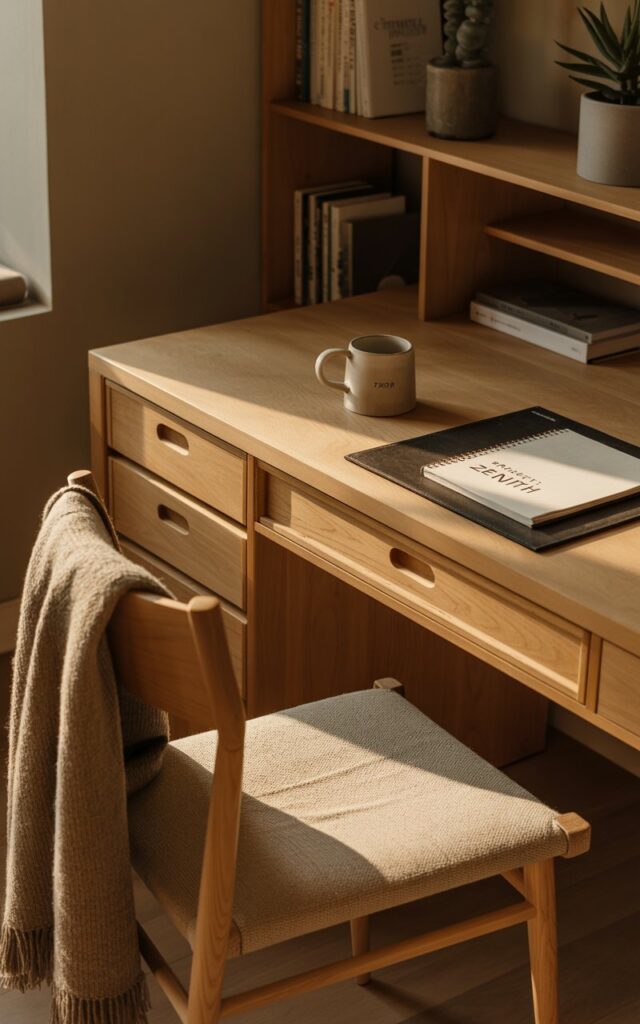
Even in a minimal space, comfort matters. Add a textured throw on the back of your chair or a linen cushion under you.
A small woven pouf or a fabric footrest adds tactile softness that contrasts beautifully with wood and metal. Think quiet luxury, not cozy chaos.
20. Choose a Subtle Scent or Aroma
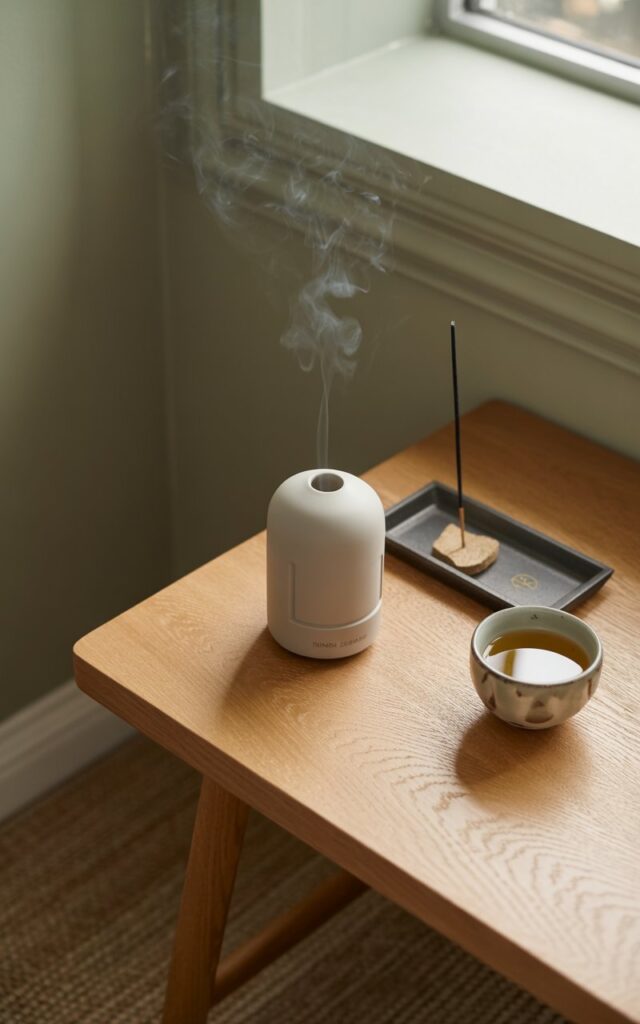
Scent changes everything.
A gentle whiff of hinoki wood, cedar, or lavender can help your brain transition into work mode—or unwind after hours.
Use a small ceramic diffuser, a few incense sticks, or essential oils in a subtle corner.
It’s an invisible design with powerful impact.
21. Add a Sliding Shoji-Inspired Partition

Need privacy but don’t want to wall yourself in? A shoji-style screen is the perfect solution.
Light, airy, and effortlessly elegant, it separates your workspace without closing it off.
When the day’s done, slide it back and your office disappears—like a magic trick for your peace of mind.
22. Use Low Furniture to Open Up the Room
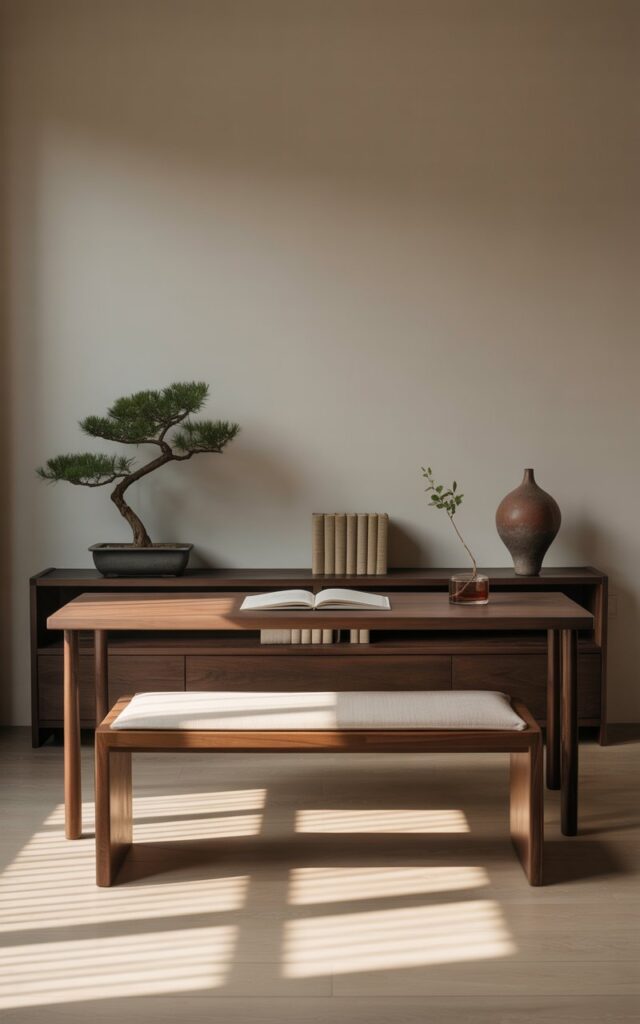
Tall furniture can feel imposing.
Japandi favors low-slung shelves, desks, and even seating. It keeps sight lines clear and makes small spaces feel bigger.
A bench instead of a filing cabinet, or a low console under your shelves, brings grounded energy while still being super practical.
23. Personalize With Intention

Don’t overdecorate—but do make it yours.
Maybe it’s a single family photo in a wooden frame, a favorite book displayed on a shelf, or a mug that just feels good in your hand.
If it inspires, calms, or brings quiet joy, it belongs. Anything else? Let it go.



